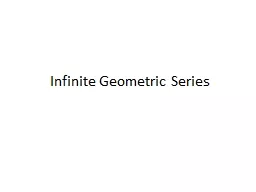

Series Find sums of infinite geometric series Use mathematical induction to prove statements Objectives infinite geometric series converge limit diverge mathematical induction Vocabulary In Lesson 124 you found partial sums of geometric series You can also find the sums of some infin ID: 536946
Download Presentation The PPT/PDF document "Infinite Geometric" is the property of its rightful owner. Permission is granted to download and print the materials on this web site for personal, non-commercial use only, and to display it on your personal computer provided you do not modify the materials and that you retain all copyright notices contained in the materials. By downloading content from our website, you accept the terms of this agreement.
Slide1
Infinite Geometric SeriesSlide2
Find sums of infinite geometric series.
Use mathematical induction to prove statements.
ObjectivesSlide3
infinite geometric series
converge
limit
diverge
mathematical induction
VocabularySlide4
In Lesson 12-4, you found partial sums of geometric series. You can also find the sums of some infinite geometric series. An
infinite geometric series
has infinitely many terms. Consider the two infinite geometric series below.Slide5
Notice that the series
S
n
has a common ratio of and the partial sums get closer and closer to 1 as
n
increases. When |
r
|< 1 and the partial sum approaches a fixed number, the series is said to
converge
. The number that the partial sums approach, as
n increases, is called a limit.Slide6
For the series
R
n, the opposite applies. Its common ratio is 2, and its partial sums increase toward infinity. When |
r
| ≥ 1 and the partial sum does not approach a fixed number, the series is said to diverge.Slide7
Example 1: Finding Convergent or Divergent Series
Determine whether each geometric series converges or diverges.
A.
10 + 1 + 0.1 + 0.01 + ...
B.
4 + 12 + 36 + 108 + ...
The series converges and has a sum.
The series diverges and
does not have a sum.Slide8
Try
1
Determine whether each geometric series converges or diverges.
A.
B.
32 + 16 + 8 + 4 + 2 + …
The series converges and has a sum.
The series diverges and
does not have a sum.Slide9
If an infinite series converges, we can find the sum. Consider the series from the previous page. Use the formula for the partial sum of a geometric series
with
and Slide10
Graph the simplified equation on a graphing calculator. Notice that the sum levels out and converges to 1.
As
n
approaches infinity, the term approaches zero. Therefore, the sum of the series is 1. This concept can be generalized for all convergent geometric series and proved by using calculus. Slide11Slide12
Find the sum of the infinite geometric series, if it exists.
Example 2A: Find the Sums of Infinite Geometric Series
1 – 0.2 + 0.04 – 0.008 + ...
r =
–0.2
Converges:
|r
|
<
1.
Sum formulaSlide13
Example 2A ContinuedSlide14
Evaluate
.
Converges:
|r
|
<
1.
Example 2B: Find the Sums of Infinite Geometric Series
Find the sum of the infinite geometric series, if it exists.Slide15
Example 2B ContinuedSlide16
Try 2a
Find the sum of the infinite geometric series, if it exists.
r =
–0.2
Converges:
|r
|
<
1.
Sum formula
125
6
=Slide17
Try
2b
Find the sum of the infinite geometric series, if it exists.
Evaluate.
Converges: |r| < 1Slide18
You can use infinite series to write a repeating decimal as a fraction.Slide19
Example 3: Writing Repeating Decimals as Fractions
Write 0.63 as a fraction in simplest form.
Step 1
Write the repeating decimal as an infinite geometric series.
0.636363... = 0.63 + 0.0063 + 0.000063 + ...
Use the pattern for the series.Slide20
Example 3 Continued
Step 2
Find the common ratio.
|
r |
<
1
;
the series converges to a sum.Slide21
Example 3 Continued
Step 3
Find the sum.
Apply the sum formula.
Check
Use a calculator to divide the fraction
Slide22
Recall that every repeating decimal, such as 0.232323..., or 0.23, is a rational number and can be written as a fraction.
Remember!